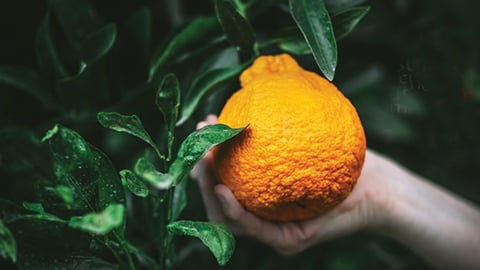Introducing Customers to Grilling Fruits
Many customers can’t wait to fire up the grill each year. Steaks, hamburgers and hot dogs are popular choices as the family prepares meals outside or in. This grilling season, produce managers can encourage customers to try grilling tropical fruits so that flavors intensify as the natural sugars caramelize, causing juicy fruits to get even juicier.
“Consumers are looking for ways to expand their healthy eating,” says Mary Ostlund, marketing manager for Brooks Tropicals, based in Homestead, Fla. “There are only so many apples and bananas you can eat. Specialty and tropical produce helps provide exciting alternatives and additions to menus and snacks.”
Grilling Adds Flavor
Key Takeaways
- Almost any tropical fruit can be grilled, outdoors or in, making the cooking method a smart way to encourage customers to eat tropical fruits they may not know or have been afraid to try.
- Caramelization occurs when the sugar of fruit is introduced to heat, and intensifies the flavor of a grilled fruit.
- To promote tropical fruits, make use of POS materials, demos, samplings, and recipes and preparation videos that are readily available on the internet.
Grilling, whether outside or indoors, is a healthy way to bring out the flavor of fruits, according to famed lifestyle maven Martha Stewart.
Her grilling suggestions for fruits include choosing a fruit that’s ripe but not too ripe. The raw fruit should be firm so that it holds up on the grill. Cut the fruit into large chunks that won’t fall between the bars of the grill grate. Grill them over high heat for three minutes without turning so the fruit will have grill marks, and then flip for one to three minutes. The site also provides recipes for tropical fruits pineapple and mango.
Star fruit, passion fruit, red guava and dragon fruit are riding a rising wave of popularity, according to Ostlund. These four fruits from the tropics are perfect grilled accompaniments to fish and steaks. Ostlund’s employer, Brooks Tropicals, grows exotic fruits and vegetables throughout Florida, the Caribbean, and Central and South America.
“Star fruit has stepped over the threshold of just being a garnish,” Ostlund notes. “Supermarkets that added this fruit’s star-shaped slices to in-store fruit salads have proven motivational to consumers.” Star fruit is a simple add-on to any dish, breakfast, lunch or dinner. If added before baking, it has a crisp, sweet taste that blends nicely with the entrée, other veggies and other fruits. Star fruit can also be eaten like an apple, bite by bite.
Additionally, the five-pointed fruit is a popular addition to the barbecue. For example, Toasted Star Fruit can be prepared directly on the grill or wrapped in aluminum foil to avoid burning it. Show your customers how to prepare star fruit at an in-store demonstration, and provide them with several recipes easily accessed on the internet. Some customers are afraid to try tropical fruits that they’ve never seen before and don’t know how to prepare or cook.
More to Explore
“Passion fruit sounds like a fruit you want to have, but you are not sure how to enjoy it,” Ostlund notes. “Anyone who’s watched ‘The Great British Baking Show’ has noticed how passion fruit seems to be in at least two or three of the dishes that contestants bake. It can’t be long before North Americans are trying this fruit in dishes they prepare.”
The gnarled-looking fruit with the sweet interior grows on a flowering vine. According to Los Alamitos, Calif.-based specialty produce provider Frieda’s, passion fruit is the largest berry of all. The color of passion fruit is purple or golden yellow. The fruit is round and about 3 inches long, with a waxy rind that becomes wrinkled-looking as the fruit ripens. Inside the fruit are sacs filled with orange-colored juice and small, crunchy seeds. The juice mixture is known as pulp. The fruit is a good source of fiber and vitamins. Again, there are recipes online for this fruit, such as a video recipe for grilled tuna with passion fruit on YouTube.
A dragon fruit display in the produce department can entice exploration by your shoppers. “They are curious to find out what the shocking-pink-and-green pointy fruit is and what else is in store for them in the specialty aisle,” Ostlund notes. The lime-green spines of this cactus fruit are supple and cover the fruit. Inside, the fruit pulp is spongy soft, similar to a kiwi but grainier. According to “Melissa’s Great Book of Produce” by Cathy Thomas, dragon fruit, also known as pitaya, tastes like a marriage between kiwi and pineapple. Add to the startling outside an inside of either bright white or deep crimson red with little black specks, and this fruit attracts attention, especially at an in-store sampling.
Don’t Toss Those Seeds!
Mary Ostlund, marketing manager at Homestead, Fla.-based Brooks Tropicals, wants people to know that the seeds of many tropical fruits are edible and tasty. Of the fruits mentioned in the main article, Ostlund asks, “Which do you toss, and which do you love?
“In all cases, the seeds can be extracted and eaten,” she notes, adding that her hope is that providing answers about seeds will stem any consumer reluctance that may exist. “In most cases, you would be tossing some great nutrients if you toss the seeds,” Ostlund asserts.
Passion fruit is a great example, with seeds that will remind consumers of sunflower seeds, both raw and baked. However, it’s difficult to separate the seeds from the flesh of passion fruit. Shoppers should check with a doctor if they’re on medication, however, as passion fruit seeds can interact with certain drugs.
By contrast, red guava’s seeds can be easily extracted and eaten. The seeds provide additional fiber, which is why guava is considered to be a fruit that helps in weight loss.
Meanwhile, dragon fruit has tiny seeds that contain fatty acids, including omega-3 and omega-9, as well as natural oils.
Additionally, pineapples can occasionally have tiny black seeds just below the peel that aren’t generally available for eating separately.
Dragon fruit is full of nutrients. Grilling cubes of it is a popular way to enjoy this unusual fruit. Make a tropical fruit kabob with cubed dragon fruit and kiwi on a skewer. Lightly brown it on the grill and add a light coating of sugar. Use a sprinkle of chili powder to balance the caramelized sweet flavor when grilling the kabobs.
Red guava, the sweet fruit that’s a mainstay in Latinos’ smoothies, pastries and sweets, is beginning to hit the sweet spot for all consumers, Ostlund observes. It can be enjoyed like an apple, bite by bite, or sliced into yogurt. Red guava is popular in barbecue sauce and as a meat marinade. One recipe on myrecipes.com is Grilled Sweet Guava Chicken, which uses the fruit in a glaze for grilled chicken.
For those who may not know, caramelization occurs when the sugar of fruit, for example, is introduced to heat. Compounds are released that change the flavor and the color of the sugar. The most immediately noticeable effect is the darkening of the sugar’s color. Caramelization can only happen in dry heat, which needs to be high for the process to happen quickly.
Perfect Pineapple
Pineapple may seem to be nothing new in produce departments, since most offer both peeled and cored items as well as with the peel tuft of pointed leaves on top. Grilling pineapple, however, may be entirely new to customers. Once they try it, though, they’ll make it a grilling staple.
A grilled slice of pineapple on top of grilled chicken can make the meal special. Jerk spices are popular now, and pineapple is the perfect partner. The grill caramelizes their natural sugars, and the taste is outstanding either on the grilled meat, or afterwards on vanilla ice cream. For the adult crowd, add rum sauce atop the ice cream and pineapple.
On Malcom Reed’s website, there’s a recipe called Fireball Pineapple in which an entire pineapple (minus skin but including the core) is grilled until it’s caramelized, after having been soaked in Fireball Whiskey for at least two hours. The cinnamon-accented whiskey adds zing to any occasion, and the recipe accentuates the fruit’s flavor.
Be sure to prepare customer POS material that includes the pineapple’s background. Millennials in particular enjoy learning about what they’re eating. Images of pineapples can be found in pre-Incan ruins in Central and South America, the first home of the pineapple. Christopher Columbus’ crew enjoyed the sweet-tart taste of pineapple on the island of Guadeloupe in 1493. Spaniards called them “piñas,” or pine cones. The English name adds “apple,” ensuring it’s known as a fruit rather than as an inedible cone, according to “Melissa’s Great Book of Produce.”
To determine whether a pineapple is ripe, look at the crown of leaves on top, which should be bright green, not dried or brown. Also, the fruit should yield to light pressure and smell fragrant. Refrigerate ripe pineapples for up to five days. A smaller version of the Gold Pineapple, Baby Hawaiian Pineapple, standing just 5 to 8 inches high, has a crunchy texture. South African Baby Pineapple is very sweet and has golden flesh. Both have edible cores.
Go Beyond Typical
What does the typical supermarket carry in the tropical fruit category? Gelson’s Markets, based in Encino, Calif., offers “a full line that begins with some standard items like pineapple, mango, bananas, papaya and kiwi,” says John Savidan, senior director of produce and floral for Gelson’s. “We also carry some tropical items that I would say are considered to be more exotic, like dragon fruit (red and yellow), mangosteen, rambutan, star fruit and cherimoya. We pretty much carry them all throughout the available seasons.”
For those interested in making the most of their tropical fruit selection, it’s not too late in the year to download Brooks’ free tropical fruit calendar from the company’s website.
Information and photos of tropical fruits are also readily available at Melissas.com and Friedas.com. Tropical fruit can be an investment for many customers, who are afraid to try and not like it. Alongside the other pointers offered here, simple in-store cuttings or demonstrations with samplings of grilled tropical fruit dishes can persuade customers to take the fruit home for barbecuing, and increase produce department profit.










